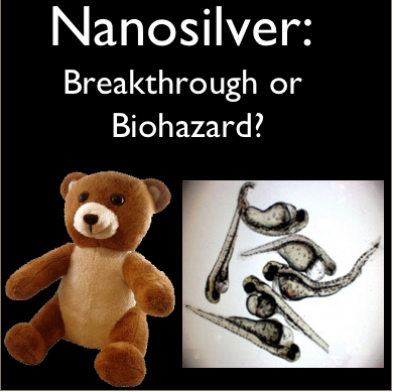DESCRIPTION
"Nanosilver: Breakthrough or Biohazard?" is a public presentation which introduces audiences to the increasingly frequent use of silver nanoparticles in consumer products. During the presentation, visitors are guided through questions such as: What is nanosilver? Why is it used in consumer products such as teddy bears and food containers? How safe is nanosilver, and how might it affect the environment? Visitors are engaged with samples of nanosilver products, various images and graphics that tell the story of nanosilver, and a demonstration that uses a plume of diet cola to show how particle size affects reactions.
DESCRIPTION
"Nanosilver: Breakthrough or Biohazard?" is a public presentation which introduces audiences to the increasingly frequent use of silver nanoparticles in consumer products. During the presentation, visitors are guided through questions such as: What is nanosilver? Why is it used in consumer products such as teddy bears and food containers? How safe is nanosilver, and how might it affect the environment? Visitors are engaged with samples of nanosilver products, various images and graphics that tell the story of nanosilver, and a demonstration that uses a plume of diet cola to show how particle size affects reactions.
TRAINING VIDEOS
OBJECTIVES
BIG IDEA
Nanosilver is used in countless consumer products as an antimicrobial agent. It offers the potential benefit of killing dangerous bacteria, but its toxicity to fish and other organisms could impact the environment negatively.
LEARNING GOALS
As a result of participating in this program, visitors will be able to:
Recognize that nanosilver products are already available for purchase.
Understand that silver is toxic to bacteria.
Define nanosilver as particles of silver small enough to be measured in nanometers, or billionths of an inch.
Understand that small particles of a material will often react more rapidly than large particles because of their large surface area.
Understand that nanosilver presents both potential benefits for people and potential risks for the environment.
NANO CONTENT MAP
Nanoscience, nanotechnology, and nanoengineering lead to new knowledge and innovations that weren't possible before.
Nanotechnologies—and their costs, utility, risks, and benefits—are closely interconnected with society and with our values.
Credits
Museum of Science
Development of this product was supported by the Center for High-rate Nanomanufacturing at Northeastern University, University of Massachusetts-Lowell, and University of New Hampshire (EEC-0425826), and the Nanoscale Science and Engineering Center headquartered at Harvard University (PHY06-46094), with support from the National Science Foundation. Packaging and dissemination for the NISE Network with funding from the National Science Foundation under Award Numbers 0532536 and 0940143. Any opinions, findings, and conclusions or recommendations expressed in this product are those of the authors and do not necessarily reflect the views of the Foundation.
Creative Commons Attribution Non-Commercial Share Alike 3.0 United States (CC BY-NC-SA 3.0 US).
View more details

NISE Network products are developed through an iterative collaborative process that includes scientific review, peer review, and visitor evaluation in accordance with an inclusive audiences approach. Products are designed to be easily edited and adapted for different audiences under a Creative Commons Attribution Non-Commercial Share Alike license. To learn more, visit our Development Process page.

